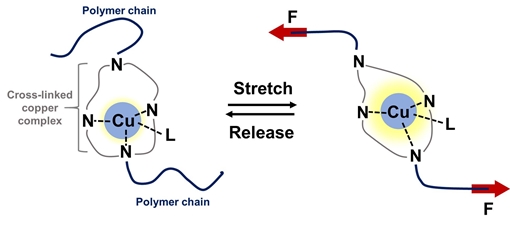|
NOVIDADES
Scientists from the Okinawa Institute of Science and Technology Graduate University (OIST) have created a stress-detecting "smart" polymer that shines brighter when stretched. Researchers hope to use the new polymer to measure the performance of synthetic polymers and track the wear and tear on materials used in engineering and construction industries. The scientists developed this polymer by incorporating copper complexes—structures formed by linking copper atoms to organic (carbon-containing) molecules—into a polymer called polybutylacrylate, which is made from a chemical used to synthesize acrylic paints, adhesives and sealants. The copper complexes, which link the polybutylacrylate chains together, naturally glow when exposed to ultraviolet light—a property known as photoluminescence. But when the polymer is stretched, the copper complexes emit light at a greater intensity, leading to a brighter glow. The copper complexes therefore act as mechanophores—compounds which undergo a change when triggered by a mechanical force.  On the left are two films of the polymer, with the copper complexes incorporated as cross-linkers. On the right are two vials of the isolated copper complexes, which were developed by Pradyna Patil, a former postdoctoral scholar. The polymer films and isolated copper complexes luminesce under ultraviolet light. Credit: Okinawa Institute of Science and Technology
"A relatively large force is required to break the chemical bond, so the mechanophore is not sensitive to small amounts of stress," said Dr. Ayumu Karimata, first author of the study and a postdoctoral scholar from the OIST Coordination Chemistry and Catalysis (CCC) Unit, led by Professor Julia Khusnutdinova. "Also, the process of breaking the bond is often irreversible and so these stress sensors can only be used once." Researchers develop a luminescent polymer that can quickly and sensitively detect stress. Credit: Okinawa Institute of Science and Technology. In contrast, the new copper mechanophores developed by the CCC unit are sensitive to much smaller stresses and can respond quickly and reversibly. In the study, published in Chemical Communications, the scientists reported that the polymer film immediately brightened and dimmed in response to being stretched and released. The scientists used a CCD camera to directly visualize the changes in brightness as the polymer was stretched and released. The false color red represents high light intensity and the false color blue represents low light intensity. The team found that the copper complexes were very dynamic, continuously distorting in shape. But as they increased in size, the copper complexes became less flexible and glowed brighter. The CCC unit believes that the larger, less flexible complexes release light more efficiently because their motion is restricted, and they therefore lose less energy as heat.  The copper mechanophore links two polymer chains together. When the polymer is stretched (force = F), the mechanophore glows brighter. Credit: Okinawa Institute of Science and Technology
 The copper complexes developed vary in size due to carbon chains of increasing length, highlighted by dashed circles. The larger molecules are less flexible, which increases the intensity of the photoluminescence emitted. Credit: Okinawa Institute of Science and Technology
"When the copper complexes are incorporated into the polymer as cross-links, the act of stretching the polymer also reduces the flexibility of the molecules," explained Karimata. "This causes the copper complexes to luminesce more efficiently with greater intensity." Although still a long way off, Dr. Karimata hopes that the acrylic polymer could eventually be adapted to create a stress-sensing acrylic paint. This could have valuable applications as a coating for different structures, such as bridges or the frames of cars and aircraft. "As we can see even from the direct visualization of the polymer, stress is applied across a material in a non-uniform way," said Karimata. "A stress-sensing paint would allow hotspots of stress on a material to be detected and could help prevent a structure from failing." By Dani Ellenby, Okinawa Institute of Science and Technology. Accessed: Feb 05, 2020. |
|||||||||||||||||||||||||